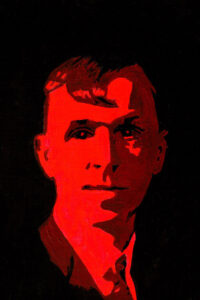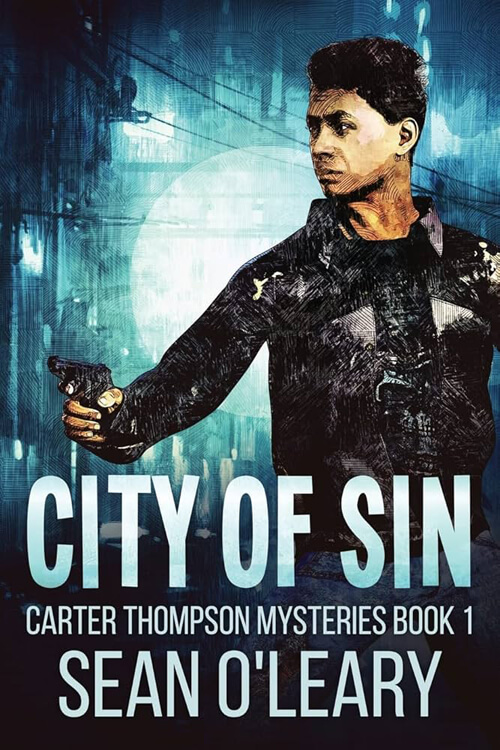
The Case of the 16 Beans
“Of course, you have one of these, I suppose—it’s the last one, I think, the old gentleman had taken. He gave me this one a couple of months back.”
“No,” said Boyce interestedly, catching a glimpse of the front of it, “I haven’t. He ran out of copies before he got as far as me—then the photographer burned up, and no more could be gotten.” Curiously and sadly, he contemplated his grandfather, who, when living, had been his only existent relative—his grandfather whom he would never again see in this world. The photograph showed Balhatchet Barkstone seated in a vast hand-carved throne chair—a little and exceedingly slight-looking man, showing plainly all the 76 years which had been his when he had died, with black string tie etched sharply against his white shirt—a combination of clothing he always wore, rain or shine, Sundays or weekdays! He was so frail in stature that one would imagine any breeze would have blown him away, and his white hair was so thin on top that he seemed practically bald. Either his eyes held a twinkle, else the twinkle was suggested by inevitable small radiating humorous wrinkles at the corners of the eyes, but at the same time, there was severity in the tightly compressed lids of those eyes and in the somewhat tight line of his lips, which betokened one who brooked no discourtesy, laxness, weakness, follies or foibles!
The lawyer set the photograph up on the back of his desk, against the wall, apologetically, as does a man doing another man an honour after it is too late to mean anything.
“But as I was saying,” he resumed, “when I thought to fetch out this photo of him, Balhatchet Barkstone certainly had nobody in the world to leave his estate to but you, Boyce. Unless ‘twas the old Negro—I’m referring to Josiah, of course—who, after all, has only been with him ten years as it is. And I think he rewarded Josiah very handsomely for that ten years of service—in that bequest of $10,000 cash, plus the full use of his bungalow up there on Van Cortlandt Park during the entire year of Probate—and then all the furnishings therein.”
Boyce Barkstone’s face was grim.
“It was Josiah who was the cause of my being cut off this way,” he said quietly.
“You mean,” queried the lawyer, “that he influenced your grandfather against you?”
Read or download Book
Harry Stephen Keeler
Harry Stephen Keeler (November 3, 1890 – January 22, 1967) was a prolific but little-known American fiction writer. He developed a cult following for his eccentric mysteries and science fiction.
Biography
Born in Chicago in 1890, Keeler spent his childhood exclusively in this city, which was so beloved by the author that many of his works took place in and around it. In many of his novels, Keeler refers to Chicago as “the London of the West”. The expression is explained in the opening of Thieves’ Nights (1929):
Here were seemingly the same hawkers selling the same goods. Here, too, was the confusion, the babble of tongues of many lands, the restless, shoving throng containing faces and features of a thousand racial castes. Last but not least, here on Halsted and Maxwell streets, Chicago, were the same dirt, flying bits of torn paper, and confusion that graced the junction of Middlesex and Whitechapel High streets far across the globe.
Other locales for Keeler novels include New Orleans and New York. In his later works, Keeler’s settings are often more generic, such as Big River or a city in which all buildings and streets are either nameless or fictional. Keeler is known to have visited London at least once.
Early adulthood
Keeler’s mother was a widow several times over who operated a boarding house popular with theatrical performers. Beginning around age sixteen, Keeler wrote a steady stream of original short stories and serials that were subsequently published in many small pulp magazines of the day. Circa 1910, when Keeler was about twenty, his mother committed him to an insane asylum for reasons unknown. This initiated Keeler’s interest in madness, asylums, and the predicament of sane people who had been consigned to such institutions. It also gave him a lifelong violent antipathy towards the psychiatric profession.
Keeler attended the Armour Institute (now the Illinois Institute of Technology) and graduated with a degree in electrical engineering. At this time, Keeler met his future wife, Hazel Goodwin, whom he would marry in 1919. After graduation, he worked as an electrician in a steel mill, working daily and writing by night. A notable early work was the 1915 science fiction story “John Jones’ Dollar”, initially published in a magazine entitled The Black Cat. A reprint would appear in an early (1927) issue of Amazing Stories, the first American science fiction pulp. In the story, a single invested dollar has grown to a fortune by the 33rd century due to compound interest. With E. P. Dutton, Eight of Keeler’s earliest works first appeared in pulp fiction magazines like Complete Novel and Top Notch.
His first four novels were initially released in England by Hutchinson, beginning in 1924 with The Voice of the Seven Sparrows. Starting in 1927, E.P. Dutton took over the publication of Keeler’s novels in the US. Between 1927 and 1942, Dutton released 37 novels by Keeler. In the United Kingdom, the publication of Keeler’s novels, sometimes with altered titles and reworked prose, fell to Ward, Lock & Co., who published 48 books by Keeler from 1929 to 1953. The Voice of the Seven Sparrows introduced audiences to Keeler’s complicated “webwork plot” storylines with wildly improbable in-story coincidences and sometimes sheerly baffling conclusions. Keeler’s complex, labyrinthine stories generally alienated his intended reading audience.
However, because of his popularity with Dutton, Keeler gained notoriety in the mid-1930s as a purveyor of new and original stories. His popularity peaked when his book Sing Sing Nights was used to “suggest” two different low-budget mystery-adventure films, namely Sing Sing Nights (Monogram Pictures, 1933) and The Mysterious Mr Wong (Monogram, 1935), the latter of which starred screen legend, Bela Lugosi. During this period, Keeler was employed as an editor for Ten Story Book, a popular pulp short-story magazine that also included photos of nude and scantily clad young women. Keeler filled the spaces between the features with his peculiar humour and included illustrations his wife drew. Here, he also often publicized his books.
Keeler’s relations with the Duttons grew erratic and strained. Keeler’s 1941 novel The Peacock Fan appears to take a dig at the Duttons through a pair of faintly disguised characters. In his later career, Keeler’s fiction and writing style grew more bizarre, and his books lasted longer. He often substituted the plot with lengthy dialogue and diatribes between characters. His readership was flagged. In 1942, after releasing The Book with the Orange Leaves, Keeler was dropped by Dutton. Ward, Lock & Co. continued to issue his books in the United Kingdom until 1953.
Later years
The years from 1942 to 1953 were difficult for Keeler. His writing drifted even further beyond the norm, and short stories written by his wife (a moderately successful writer) were found increasingly in his novels. Keeler typically padded the length of his novels with the following device: his protagonist would see a magazine or book, open it randomly, and discover a story. At this point, Keeler’s novel would insert the complete verbatim text of one of his wife’s short stories, this being the story his novel’s protagonist was reading. At the end of the story, the novel would continue where it left off, several pages nearer to its contractual minimum word count. These stories within the novel typically contained only a few scraps of information relevant to the novel in which they appeared.
Keeler’s novels were picked up by rental library publisher Phoenix Press, known in the business as the “last stop on the publishing bus”. By 1953, British publishers Ward, Lock & Co. printed their final Keeler novel, thus forcing the writer to pen his stories exclusively for an overseas market with stories often translated for publication in Spain and Portugal.






